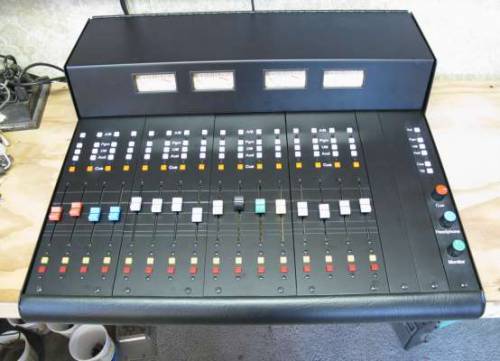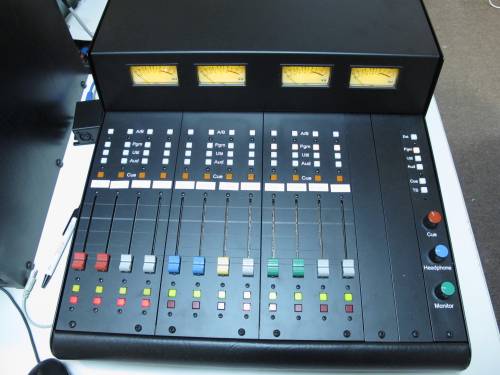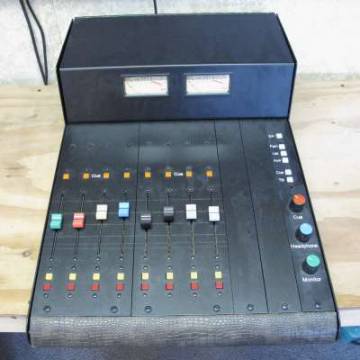Kaatskit Radio Company
Products
Consoles, and console modules
All of our consoles are modular, using “quad-modules”, four inputs in a module. Combining in groups of four provides most of the advantages of a fully modular design at a lower cost and smaller size.
Here are three, in 3 different sizes.
The small one is simple. 8 faders, full monitor, the basic input module. The big one meets the needs of most … 16 faders, the complete input module. The one in the middle is a good fit for a small studio … 12 faders, the complete input module.
Mainframes are available in sizes from 2 bays (8 faders max, or 4 faders with monitor) up to 8 bays (32 faders max, or 28 with monitor).
Input modules
We offer three types of input modules:
- A “3-bus” module, comparable to what you get with the best analog consoles. There are three stereo buses, “Program”, “Audition”, and “Utility”. Each has two stereo inputs (A/B) with separate gain trims.
- A simple “basic” module, for simpler applications and lower cost. It really has 3 buses. There are no bus assign switches, keeping it simple. You assign the buses with jumper plugs on the back, so it is sort of a permanent configuration. It's the same as the 3-bus module except that some parts, mostly switches, are left out to reduce the cost and complexity.
- An even simpler “unbalanced” version. This is the same as the “basic”, except that there is no input buffer and no gain trim. The gain is fixed, for ”-10 dBv” for most consumer devices. It also uses the less expensive “thin” style faders. It keeps the cost down.
All modules are the same size, and are interchangeable. As you would expect on any real broadcast board, all have “cue”, “talkback”, and remote starts. Connections are RJ-45 jacks, fully “Studiohub+” compatible, including power.
Build options
Our main product is console kits, but we do also offer fully assembled consoles.
To save you more money, and to give you more flexibility, you can buy “a-la-carte”. That way you can make little mixers, submixers, and other things we didn't think of.
Technical details
Inputs:
Type: Two op-amp instrumentation balanced.
Nominal level: adjustable from -9 dbu (-11 dbv) to +7 dbu
Input impedance: 40k differential, 20k single-ended.
Headroom: 28 db above nominal level.
(+20 dbu when set for -8 dbu, +32 dbu when set for +4 dbu)
Common mode range: +/- 70 volts (140 v p-p)
Connection: RJ-45, industry standard, Studiohub+ compatible, with power
Remote start: Open collector, grounded when on, A input only.
Each fader has “A” and “B” stereo inputs, with separate gain trims.
Outputs:
Type: Choice of floating balanced or non-floating balanced.
Clip level:
Non-floating: 48 v p-p, +26 dbu
Floating: 24 v p-p, +20 dbu, with one side grounded, +26 dbu with balanced load.
Calibration: Adjustable from -9 dbu to +5 dbu nominal
Connection: RJ-45, industry standard, Studiohub+ compatible, with power
Outputs: 3 stereo mix buses: “Program”, “Utility”, “Audition”
Mono “Cue” and “Talkback”
Monitor outputs: “Monitor”, “Headphones”, “Cue”, “Switched”
VU meters:
Type: Analog VU meter, buffered, illuminated
Meter Calibration: +4, -2, -8 dbu nominal
trim -6 to +3 db relative to nominal
Meter reads actual output.
RJ-45 jack so meter can be used for other measurements.
Mix-bus:
Clip level: 28 db above nominal
Construction:
Through-hole components, IC's in sockets.
Most caps rated long-life, 105°C.
Non-polar caps in audio.
Plug-in 100mm rail type faders.
Manuals
- Input module
- Monitor module
- Output module
- Chassis


